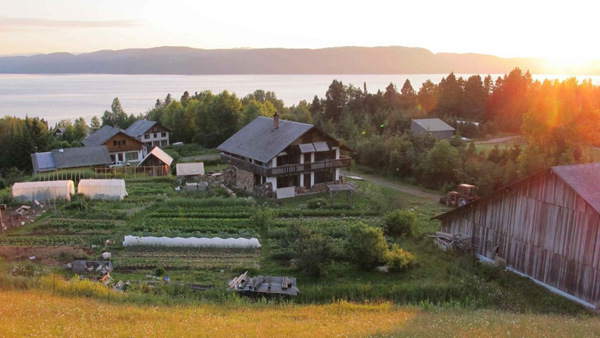
“The continent hosts so many pioneers who are looking for other living ways. We are out to meet some of them in Quebec. Starting with the inhabitants of the Bay eco-village, who invented a straw building technique which is heard of in Europe event and beyond, too: the GREB technique. Behind those initials there is the « Bay Ecological Research Group » which, for 25 years now, has been experimenting a post-petrol way of life!
With a taste for challenges, Pierre and Marie-Thé return to Quebec in 1988. Together with five other families, they purchase a piece of land of several hectares and decide to create an eco-village on waste agricultural and wooden lands. A key stage, prior to settling down, it was necessary to analyse the resources available and to observe the territory, so as to consider the possibilities and limits of this eco-system. So for most inhabitants, building with straw balls and a wooden framework proved to be the most relevant choice!
Using straw to build? Despite prejudices which are still going strong, the idea is gradually becoming accepted.
It is quite cheap, there is plenty of straw everywhere, it has very good thermal and sound insulation qualities as well as many other properties – this is why straw is used more and more by the self-builders and some professionals, too. But in 1996, when Patrick Déry and martin Simard build one of the first straw houses in the village, the slow process leads them to find another more efficient technique. Then they come up with the idea of erecting a wooden double framework, compress the straw balls inside, and pour mortar with a formwork. After several attempts, the better adapted mortar finally consists in 3 volumes of sand, 4 volumes of sawdust, 1 volume of air lime and 1 volume of cement. The GREB technique was born!
What are the advantages of this technique compared to other straw buildings?
It is fast and simple (it may easily be chosen by self-builders) and so the costs are considerably lower. For instance, one of the houses of the small village, some 150m2, was built in 9 months and 3 weeks of that time were necessary to fill the framework with the straw balls. Its total cost amounted to euro 100,000.
Patrick tells us a small story about that, which took place in the early days of the village « in 1996, there was a very huge storm in Saguenay. Suddenly the people found themselves cut off the networks and for many of them, it was sheer panic. Just imagine, no light, no heating … and of course in the middle of the winter! The people who lived in Saguenay were evacuated. We were also called, but we did not want to leave because we had everything we needed! Food from the summer, enough water, heating through the masonry heater… For many people that storm proved a real nightmare, and meant anxiety. We managed to consider that event in a serene way since we had already embarked on a resilient approach…“
More at the source: Eco-Logis.org

100000 euros for a 150m2 house? from straw bales?
These are higher end, nice homes with masonry heaters, etc. not budget homes.
There are thousands of ecovillages all over the world. In a sense they are test sites for natural building, permaculture, renewable energy, community development and so on. They attract natural builders and many other skilled people. They’ve been experimenting with alternative ways of doing things for years and therefore are excellent sources of information. Tours and workshops are often available to help others learn.